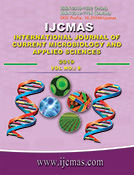


 National Academy of Agricultural Sciences (NAAS)
National Academy of Agricultural Sciences (NAAS)

|
PRINT ISSN : 2319-7692
Online ISSN : 2319-7706 Issues : 12 per year Publisher : Excellent Publishers Email : editorijcmas@gmail.com / submit@ijcmas.com Editor-in-chief: Dr.M.Prakash Index Copernicus ICV 2018: 95.39 NAAS RATING 2020: 5.38 |
The genetic relationship among 14 spatially segregated populations of Karnataka and one each population from Kerala and Gujarat was established using polymerase chain reaction and arbitrary primers. A total of 24 random decamer DNA primers belonging A, B, C, G, H, I and ‘L’ series were used for RAPD-PCR. The lowest genetic similarity was noticed between the farthest populations and highest between the closest populations. Higher similarity index values were found among the populations within Karnataka. Pooled data revealed the lowest genetic similarity index of 0.63 between Kerala and Gujarat populations followed by 0.68 each between Kadur and Gujarat populations. A maximum genetic similarity of 0.98 was recorded among Malpe and Padubidre populations (Mangalore taluk). The overall genetic similarity between populations of O. arenosella ranged from 63 to 98%, which may be considered as ‘high’. On a broad scale, results obtained agreed with the hypothesis proposed that spatial distance and genetic similarity were inversely related. High genetic similarity between the populations of O. arenosella suggests 1) populations arise from a common nucleus population, 2) populations inbreed and 3) immigration/emigration is practically zero. Corroborating with the argument, the polyphagous and migratory species like Helicoverpa armigera is reported to have a higher levels of genetic variability among the populations within and between locations.
 |
 |
 |
 |
 |